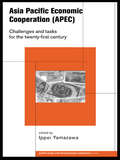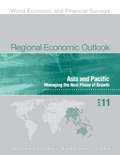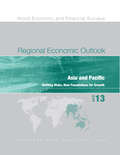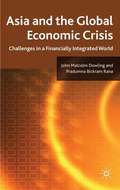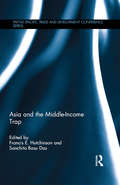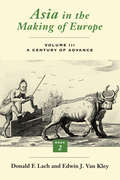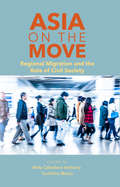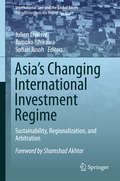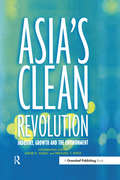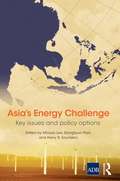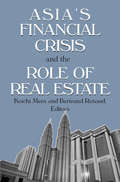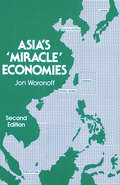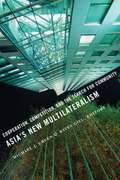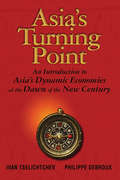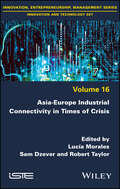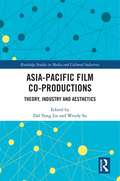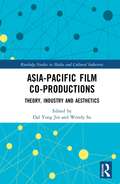- Table View
- List View
Asia Pacific Economic Cooperation: Challenges and Tasks for the Twenty First Century (PAFTAD (Pacific Trade and Development Conference Series))
by Ippei YamazawaThis book provides the most up-to-date and comprehensive account of the APEC (Asia Pacific Economic Cooperation) organisation and examines the challenges APEC now faces in the new century. Subjects covered include:* the history of APEC* APEC and the latest WTO round* case-studies of countries in the region including China, Japan, Malaysia, Korea and Taiwan* APECs approach to competition and deregulation policy* assessment of APECs standing as an international institutionFeaturing contributions from distinguished groups of international academic experts, this book is essential reading for all those interested in political and economic developments in the Asia-Pacific.
Asia Renal Care
by Michael J. RobertsPresents a business plan for a start-up company focused on building a network of high-quality dialysis centers in the Asia-Pacific region. Includes a detailed financial forecast. Students have the opportunity to run various roll-out strategies and focus on different Asian countries. Teaching purpose: To allow students to better understand the financial and economic underpinnings of the business.
Asia and Pacific Managing the Next Phase of Growth
by International Monetary FundThe April 2011 issue of the Regional Economic Outlook: Asia and Pacific focuses on the policy challenges of managing the next phase of growth after Asia's recovery from the global crisis. The analytical chapters discuss how capital flows To The region may affect the monetary policy transmission mechanism And The role of macroprudential measures in this context, The implications of the Asian supply chain for rebalancing growth across the region, And The policy challenges for Asian low-income and Pacific Island countries. Economic recovery in Asia as a whole has been rapid (8. 3 percent in 2010) and fueled by both exports and domestic demand. Looking ahead, growth is expected to continue at a more moderate but also more sustainable pace in 2011 and 2012, led by China and India. Meanwhile, new risks To The outlook have emerged. The full human cost and impact on infrastructure of the mid-March earthquake and tsunami in Japan remain to be determined. The steady response of the Japanese government and people has helped to contain the effects of the disaster on production, but a risk remains of prolonged disruptions in production that could spill over to other Asian economies in the regional supply chain. Moreover, tensions in the Middle East and North Africa and related risk of further oil price spikes could disrupt global growth and affect Asian exports. Finally, pockets of overheating have emerged in Asia, As core inflation and credit growth have accelerated in several Asian economies. The need to tighten macroeconomic policy stances has become more pressing than it was six months ago.
Asia and Pacific: Shifting Risks, New Foundations for Growth
by International Monetary FundA report from the International Monetary Fund.
Asia and the Global Economic Crisis
by John Malcolm Dowling Pradumna Bickram RanaThis book provides an analysis of the global economic crisis from an Asian perspective. It examines the impacts of the policy measures adopted, the remaining challenges in rebalancing the global economy, the next steps in regional economic integration in Asia, and issues related to reform of the international financial architecture.
Asia and the History of the International Economy: Essays in Memory of Peter Mathias (Routledge Studies in the History of Economics)
by A.J.H. Latham Heita KawakatsuThis collection of essays sheds new light on many aspects of Asia’s integration with the international economy. H.I.H. Crown Prince Naruhito discusses the problems of controlling water in the interest of urban development. He first examines the problems encountered on the River Thames in relationship to the growth of London in the eighteenth century, and then relates his findings to Japan where similar problems arose with respect to the expansion of Edo (Tokyo). Other chapters looking at the eighteenth century examine the development of plant collecting in Asia and the wider world in the interest of the economy and leisure, Japan’s connections with the outside world by way of the Dutch East India Company (VOC), and the Dutch acquisition of the knowledge of the Japanese language at their base at Dejima Island, Nagasaki. India features next with a chapter showing how India was crucial in initiating the industrial revolution in Britain, by stimulating British manufacturers to copy the fine textiles made by hand loom weavers there. This is followed by a chapter showing how in the late nineteenth century India was the central pivot in the entire international economic system, based on its trading surplus with China. Other discussions trace the role of Scotland as a centre of heavy industry and shipbuilding, with Scottish companies dominating the shipping lanes of Asia. A further chapter shows how British connections with Asia, in this case Shanghai, brought problems of debt and non payment, and outlines the steps taken to try to control the situation. Elsewhere problems arose in Bangkok over the quality of rice being supplied to European merchants in the 1920s, leading to a decline in sales. Finally there is a discussion of Japanese commercial policy towards Africa in the inter-war period. This book will be of interest and use to students, researchers, and general readers interested in Asia’s role in world economic development.
Asia and the Middle-Income Trap (PAFTAD (Pacific Trade and Development Conference Series))
by Francis E. Hutchinson Sanchita Basu DasThe term ‘Middle-Income Trap’ refers to countries which stagnate economically after reaching a certain level of per capita income on the basis of labour- and capital-intensive growth, and are struggling to transition towards more skill-intensive and technology-driven development. It has resonance for the increasing number of countries in Asia who have either languished in middle-income status for extended periods of time, or are worried about growth slow-downs. This book sets outs the conceptual underpinnings of the Middle-Income Trap and explores the various ways it can be defined. It also focuses on the debate surrounding the Middle-Income Trap which questions the appropriate institutional and policy settings for middle-income countries to enable them to continue past the easy phase of economic growth. The book engages with this debate by investigating the role of institutions, human capital, and trade policy in helping countries increase their income levels and by highlighting factors which enable the shift to higher and qualitatively better growth. It questions how the large emerging economies in Asia such as China, Indonesia, and India are currently grappling with the challenges of transitioning from labour-intensive to technology- and knowledge-intensive production, and discusses what can be learnt from the countries that have been able to escape the trap to attain high-income status. Providing a conceptual framework for the Middle-Income Trap, this book will be of interest to students and scholars of Asian Economics, Comparative Economics and Asian Studies.
Asia in the Making of Europe: Volume III, A Century of Advance
by Donald F. Lach Edwin J. Van KleyThis monumental series, acclaimed as a "masterpiece of comprehensive scholarship" in the New York Times Book Review, reveals the impact of Asia's high civilizations on the development of modern Western society. The authors examine the ways in which European encounters with Asia have altered the development of Western society, art, literature, science, and religion since the Renaissance. In Volume III: A Century of Advance, the authors have researched seventeenth-century European writings on Asia in an effort to understand how contemporaries saw Asian societies and peoples.
Asia on the Move: Regional Migration and the Role of Civil Society
by Mely Caballero-Anthony Toshihiro MenjuGlobalization has led to a surge in cross-border migration, leading the number of international migrants in East Asia to more than double over the past two decades. Carefully managed migration can spark economic growth and innovation, while helping destination countries with aging populations overcome human resource constraints. However, irregular migration has been on the rise as well, which not only places migrants in a vulnerable position with no legal recourse but also is linked to trafficking, smuggling, and even terrorism. Clearly, migration-whether regular or irregular-needs to be managed more effectively to handle the expanding and increasingly complex flows of people as well as the human security challenges they bring. In this volume, experts from "sending" and "receiving" countries in Northeast and Southeast Asia identify current migration trends, analyze government efforts to manage migration, and explore the unique role that nongovernmental organizations can play in helping to protect migrants and to harness migration to the benefit of the region.
Asia's Changing International Investment Regime: Sustainability, Regionalization, and Arbitration (International Law and the Global South)
by Julien Chaisse Tomoko Ishikawa Sufian JusohThis book focuses on the Asia-Pacific region, delineating the evolving dynamics of foreign investment in the region. It examines the relationship between efforts to increase foreign direct investment (FDI) and efforts to improve governance and inclusive growth and development. Against a background of rapidly developing international investment law, it emphasises the need to strike a balance between these domestic and international legal frameworks, seeking to promote both foreign investment and the laws and policies necessary to regulate investments and investor conduct. Foreign investments play a pivotal role in most countries' political economies, and in order to encourage cross-border capital flows, countries have taken various steps, such as revising their domestic legal frameworks, liberalising rules on inward and outward investment, and creating special regimes that provide incentives and protections for foreign investment. Alongside the developments in domestic laws, countries have also taken bilateral and multilateral action, including entering into trade and/or investment agreements. Further, the book explores regional investment trends, highlights specific features of Asia-Pacific investment laws and treaties, and analyses policy implications. It addresses four overarching themes: the trends (how Asia-Pacific's agreements compare with recent global trends in the evolving rules on foreign investment); what China is doing; current investment arbitration practice in Asia; and the importance of regionalising investment law in the Asia-Pacific region. In addition, it identifies and discusses the research and policy gaps that should be filled in order to promote more sustainable and responsible investment. The book offers a valuable resource not only for academics and students, but also for trade and investment officials, policy-makers, diplomats, economists, lawyers, think tanks, and business leaders interested in the governance and regulation of foreign investment, economic policy reforms, and the development of new types of investment agreements.
Asia's Clean Revolution: Industry, Growth and the Environment
by David Angel Michal RockThe world's environmental future will be determined in significant part by what happens in the rapidly industrialising and urban economies of Asia. The sheer scale of urban population and industrial growth in Asia - from Indonesia to China - and the energy and materials intensive character of the development process constitutes a dark shadow over the region's, and indeed the world's, environment. And yet this challenge is also an opportunity. Precisely because so much of the urban-industrial investment within developing Asia has yet to take place, the opportunity exists to shape a different development future - one that is far less energy, materials and waste intensive.Asia's Clean Revolution examines the prospects for and pathways to such a new trajectory. The book lays out a path-breaking vision of how developing economies might go beyond environmental regulation and put in place an array of policies and institutions that could integrate environmental, industrial and technological goals. These findings provide important input for negotiators considering climate change on a global scale.The book approaches the challenge of growth and environment in Asia in a novel way, by identifying six major transformational dynamics under way in the world today, and assessing whether these can be harnessed to the goal of improved environmental performance of industry.With a set of specially commissioned chapters from the leading authorities in North America and Asia, this ground-breaking book is the first to present concrete policy solutions to the looming crisis driven by large-scale urban-industrial growth in developing Asia.
Asia's Energy Challenge: Key Issues and Policy Options
by Donghyun Park Minsoo Lee Harry D. SaundersThis book examines key issues and policy options of developing Asia’s energy security. Rapid growth has transformed Asia’s presence in the world economy. Past growth has dramatically improved Asia’s living standards, lifting millions out of poverty. Future growth will do the same. But, crucially, can Asia secure the energy it needs to fuel this dramatic economic expansion? This book stresses that the threefold challenge of energy supply security, environmental sustainability, and affordable access requires a multipronged approach. The book also explains that the region must actively contain its rising demand, aggressively explore new energy supply sources and technology, and progressively promote the regional integration of energy markets and infrastructure. The book also highlights that unless there is a paradigm shift in the current energy use, Asia will struggle to deliver the inclusive growth needed to lift millions of its citizens out of poverty. The book also considers the range of policy reforms and technological developments that can ensure a future of ample, affordable, clean energy for Asia.
Asia's Entrepreneurs: Dilemmas, Risks and Opportunities
by Virginia Cha Jennifer LienThis book is a collection of technology startup cases in Asia, told in a narrative form, to give readers an insider view to how innovators and technopreneurs view entrepreneurial opportunities from use of technology, how the technopreneurs raise funding to support their vision, and the subsequent relationship of the technopreneurs and their investors. The book illustrates some of the cases using the theory of effectuation. The book is divided into four sections: Part One chronicles case studies of technopreneurs who raised capital but had difficulty with managing the investor expectations and relationship, to the detriment of the venture. Part Two chronicles case studies of technopreneurs who started their ventures without venture capital, with some who later raised capital at a much later stage, and were able to exit successfully. All case studies are of technology ventures in Asia from the mid-1990’s where venture capital and entrepreneur ecosystem were under-developed. Lessons learned from the various case studies are told from a practitioner’s perspective. Part Three describes the development of the venture ecosystem, specifically in Singapore, a city-state aspiring to follow the Silicon Valley model. The technopreneurs in Parts I and II play the roles of mentors/investors in the newly developing system. Part Four includes two new young technology ventures’ fund raising dilemmas, written in a teaching case format. The book can be used by practitioners and by educators for developing a deep understanding on the issues of raising capital for the purpose of growing the venture, and the trade-offs of capital from the different groups of investors and their financial terms. It is useful to young and mid-career professionals looking at starting a technology venture in Asia.
Asia's Financial Crisis and the Role of Real Estate
by Bertrand Renaud Koichi MeraThis book by a distinguished academic and a professional economist from the World Bank clearly demonstrates the significant role played by the real estate sector in inducing the Asian crisis; the linkage of the real estate sector to the general economy; the causes of real estate booms and subsequent busts; and the economic costs of real estate price volatility. The book also includes suggestions for moderating such volatility in the future.
Asia's Miracle Economies
by Jon WoronoffAn expanded and updated edition of Woronoff's 1986 study of Asia's emerging economic giants, this book looks back at what has happened in the intervening years, especially as regards the "discovery" of this phenomenon in the Western media and the overreactive hype that has accompanied it. As the author puts it: "My purpose is to show how these countries, which hitherto has been quite unremarkable, began to develop vigorously. What policies and strategies they used. What they did right and, even more importantly, what they did wrong."
Asia's New Multilateralism: Cooperation, Competition, and the Search for Community
by Bates Gill Michael J. GreenTraditionally, stability in Asia has relied on America's bilateral alliances with Japan, Australia, and the Republic of Korea. Yet in recent years, emergent and more active multilateral forums-such as the Six-Party Talks on North Korea and the East Asia Summit-have taken precedence, engendering both cooperation and competition while reflecting the local concerns of the region. <P><P>Some are concerned that this process is moving toward less-inclusive, bloc-based "talking shops" and that the future direction and success of these arrangements, along with their implications for global and regional security and prosperity, remain unclear. The fifteen contributors to this volume, all leading scholars in the field, provide national perspectives on regional institutional architecture and their functional challenges. They illuminate areas of cooperation that will move the region toward substantive collaboration, convergence of norms, and strengthened domestic institutions. They also highlight the degree to which institution building in Asia-a region composed of liberal democracies, authoritarian regimes, and anachronistic dictatorships-has become an arena for competition among major powers and conflicting norms, and assess the future shape of Asian security architecture.
Asia's Social Entrepreneurs: Do Well, Do Good... Do Sustainably
by Howard Thomas Havovi JoshiSocial enterprises of all forms drive inclusive growth by creating social and economic networks, and a stable ecosystem, that enable societies to grow and prosper. This book presents a collection of ten case studies that demonstrate the important role played by social enterprises in driving inclusive growth in Asia’s economies. Unlike the traditional models, such as NGOs and charities, that are donor dependent for funding, a social enterprise is a hybrid business model that includes both social mission and revenue generation goals to ensure sustainability and self-reliance. The ten case studies in the book provide a ringside view of how social enterprises operate and evolve to create, sustain, and scale up their social impact. Readers will gain a practical understanding of how social entrepreneurs struggle to maintain a balance between their two seemingly contradictory goals of creating social value and generating economic returns. The book carries the readers on the journey of each of these ten social enterprises, offering unique and valuable insights into the motivations, tribulations, successes, and even failures of these organisations—critical for continued learning, contribution, and innovation in the domain. The book is appropriate for all readers interested in the role social entrepreneurship plays in stimulating economic growth in Asia, including organisations, government, and universities, as well as individuals.
Asia's Star Brands
by Paul TemporalASIA'S STAR BRANDSAsian brands have come of age, and no longer can be seen as "also rans" to their Western competitors. The problem is, very little has been know about them. Paul Temporal's book fills this gap, with a series of practical 'brand biographies' which chart both the growing pains and the growth potential of the new contenders from the East. It's vital reading for anyone committed to doing business in Asia. - Miles Young, Chairman, Ogilvy & Mather, Asia PacificChina and Japan, as well as India and the Emirates, suggest remarkable achievements by local companies in the field of branding and brands. Such a revolution shall impact not only the regional markets but also the world economy and non-Asian firms. Paul Temporal's book provides spectacular business cases and broader key lessons. it should become a major reference for any practitioner and scholar, whether Asian or not. I rank it in my short list of relevant texts about competition and success in the coming years. - Professor Jean-Claude Thoenig, INSEADA well-managed brand is the lifeline of any successful company. this helpful book explains how Asian companies have built their brands to create sustainable competitive advantage. Using up-to-date Asian case studies, it will help readers have a better understanding of the creation, management and evolution of brands. - Professor John Quelch, Harvard Business SchoolIt is often said that the 21st Century is Asia's. It is very encouraging to see many Asian brands succeeding, as wonderfully showcased by Paul Temporal, both regionally and globally. Branding is investment for the future.
Asia's Turning Point
by Ivan Tselichtchev Philippe DebrouxAsia was probably the biggest economic sensation of the post-war decades. The breathtaking success of Japan was followed by a remarkable rise of "four tigers", then ASEAN founder states and then China. The Asian miracle became a commonly accepted definition of this success. In the late 1970s and especially 80s it became clear that the balance of power in the world had changed. Politicians, businessmen, scholars began to talk about "the new Asia Pacific age" and Asian economic model, different from and, maybe, even superior to Western capitalism. However, in 1997-98 the Asian economic crisis came and made the region a sick man. Six years before that Japan, the regional powerhouse entered more than a decade-long period of stagnation. The miracle was over. However, the crisis was overcome within a surprisingly short period of time. Naturally, the question arises: What now? What is going on in the region after the miracle and after the crisis? What is today's face of Asian capitalism and how should we view its performance?Readers interested in regional developments will find a lot of literature about miracle decades and crisis years. However, few analysts have addressed the challenging questions addressed in this book.The authors vividly show that Asian capitalism is undergoing a radical structural transformation. These changes are directly affecting its key institutions: governments, companies, labor relations, etc. As a result Asian economic systems are becoming much closer to the Western-style, especially Anglo-Saxon capitalism, though the region retains some important specific features, especially regarding business culture.This book is a must for business people worldwide, for all those who study the region in colleges and business schools, for people engaged in various international activities and, finally, for all those who want learn more about our world at the dawn of the new century.
Asia-Africa Growth Corridor: Development and Cooperation in Indo-Pacific
by Sachin Chaturvedi Anita Prakash Priyadarshi DashThis book is a rich addition to the existing knowledge on models of development partnership among developing countries. Unlike the Belt and Road Initiative (BRI), which exclusively focuses on physical infrastructure development with a strong financing component by China, the Asia–Africa Growth Corridor (AAGC) envisages a holistic approach toward development partnership based on the spirit of triangular cooperation, demystifying the donor-recipient model of development cooperation. By integrating four distinct pillars of cooperation – connectivity and physical infrastructure, capacity building and skill development, development cooperation projects, and people-to-people and business-to-business partnerships – the book provides a succinct account of how a demand-driven people-centric model of engagement among Asian and African countries could help achieve inclusive and sustainable development without creating any fatal dependence on specific countries or institutions for external funding. In sixteen chapters, the book covers various theoretical, analytical, and policy discussions with respect to the concept and modalities of the growth corridor approach under the free, open, and inclusive Indo-Pacific; potential opportunities and challenges in economic sectors and fields like agriculture, manufacturing, trade and investment, urbanization, industrialization, human resource development, and the blue economy; social sector priorities including health, education, skill development, disaster management, and women’s participation; and policy issues relating to trade facilitation, the identification of joint projects, modalities and instruments of project execution, and related aspects. The book offers a valuable resource for students and research scholars working in the fields of development economics, development cooperation, international political economy, and international economic relations. It also serves as a handbook for governments and policymakers on issues concerning the suitability of development projects, sources of and innovations in financing, implementation and execution challenges, private sector involvement, and so on.
Asia-Europe Industrial Connectivity in Times of Crisis
by Robert Taylor Sam Dzever Lucía MoralesAsia-Europe Industrial Connectivity in Times of Crisis
Asia-Pacific Film Co-productions: Theory, Industry and Aesthetics (Routledge Studies in Media and Cultural Industries)
by Dal Yong Jin Wendy SuThis book examines cross-regional film collaboration within the Asia-Pacific region. Through a mixed methods approach of political economy and industry, market and textual analysis, the book contributes to the understanding of the global fusion of cultural products and the reconfiguration of geographic, political, economic, and cultural relations. Issues covered include: cultural globalization and Asian regionalization; identity, regionalism, and industry practices and inter-Asian and trans-Pacific co-production practices among the U.S., China, South Korea, Japan, India, Hong Kong, Argentina, Australia, Taiwan, and New Zealand.
Asia-Pacific Film Co-productions: Theory, Industry and Aesthetics (Routledge Studies in Media and Cultural Industries)
by Dal Yong Jin Wendy SuThis book examines cross-regional film collaboration within the Asia-Pacific region. Through a mixed methods approach of political economy, industry and market, as well as textual analysis, the book contributes to the understanding of the global fusion of cultural products and the reconfiguration of geographic, political, economic, and cultural relations. Issues covered include cultural globalization and Asian regionalization; identity, regionalism, and industry practices; and inter-Asian and transpacific co-production practices among the U.S.A., China, South Korea, Japan, India, Hong Kong, Taiwan, Argentina, Australia, and New Zealand.
Asia-Pacific Security Challenges: Managing Black Swans and Persistent Threats (Advanced Sciences and Technologies for Security Applications)
by Anthony J. Masys Leo S. F. LinThis edited book examines the contemporary regional security concerns in the Asia-Pacific recognizing the 'Butterfly effect', the concept that small causes can have large effects: 'the flap of a butterfly's wings can cause a typhoon halfway around the world'. For many Asia-Pacific states, domestic security challenges are at least as important as external security considerations. Recent events (both natural disasters and man-made disasters) have pointed to the inherent physical, economic, social and political vulnerabilities that exist in the region. Both black swan events and persistent threats to security characterize the challenges within the Asia-Pacific region. Transnational security challenges such as global climate change, environmental degradation, pandemics, energy security, supply chain security, resource scarcity, terrorism and organized crime are shaping the security landscape regionally and globally. The significance of emerging transnational security challenges in the Asia-Pacific Region impact globally and conversely, security developments in those other regions affect the Asia-Pacific region.

